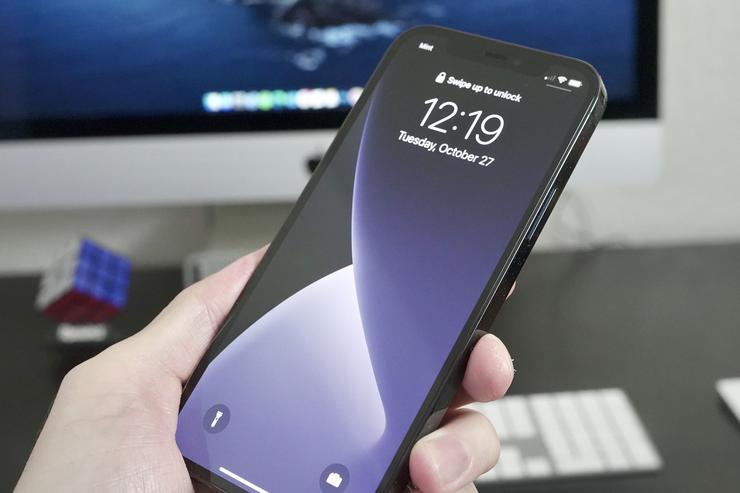 Credit: Jason Cross/IDG
Credit: Jason Cross/IDG
Every year Apple releases a new iPhone, and every year we note that it is faster and has a better camera, along with one or two other small feature changes. In rare years, like with the introduction of the iPhone X, we get a dramatic shift in design and capabilities.
The iPhone 12 Pro is sort of an odd entry in the series. Yes, it’s faster and has a better camera, though neither change is exactly seismic. And it’s got a really nice new design, but even that feels familiar and cautious. But it also has several significant new capabilities that may eventually prove to be transformative.
Call it “untapped potential” or call it “future proof,” but the iPhone 12 Pro’s most significant advancements are sort of waiting for the rest of the world to do something great with them.
A fresh new elegant design
Since the introduction of the iPhone X in 2017, Apple has stuck with essentially the same iPhone design, making a few modest tweaks each year. The iPhone 12 brings the first real change in three years, with no rounded bezels and totally flat edges, just like the iPad Pro. The iPhone 12 and iPhone 12 Pro look essentially the same—they can even use the exact same cases—but the Pro model has a stainless steel band around the outside instead of aluminum and is available in different colors. The new Pacific Blue is especially nice.
Last year’s iPhone 11 Pro had one of the best displays of any smartphone, and it’s essentially unchanged in the iPhone 12 Pro. The flat edges allow Apple to push the screen even further toward the edges, growing the display from 5.8 inches to 6.1 inches in a body almost the same size. The pixel density is about the same, and you still get great OLED contrast, color, and HDR with typical brightness up to 800 nits for standard content and 1,200 nits for HDR content.
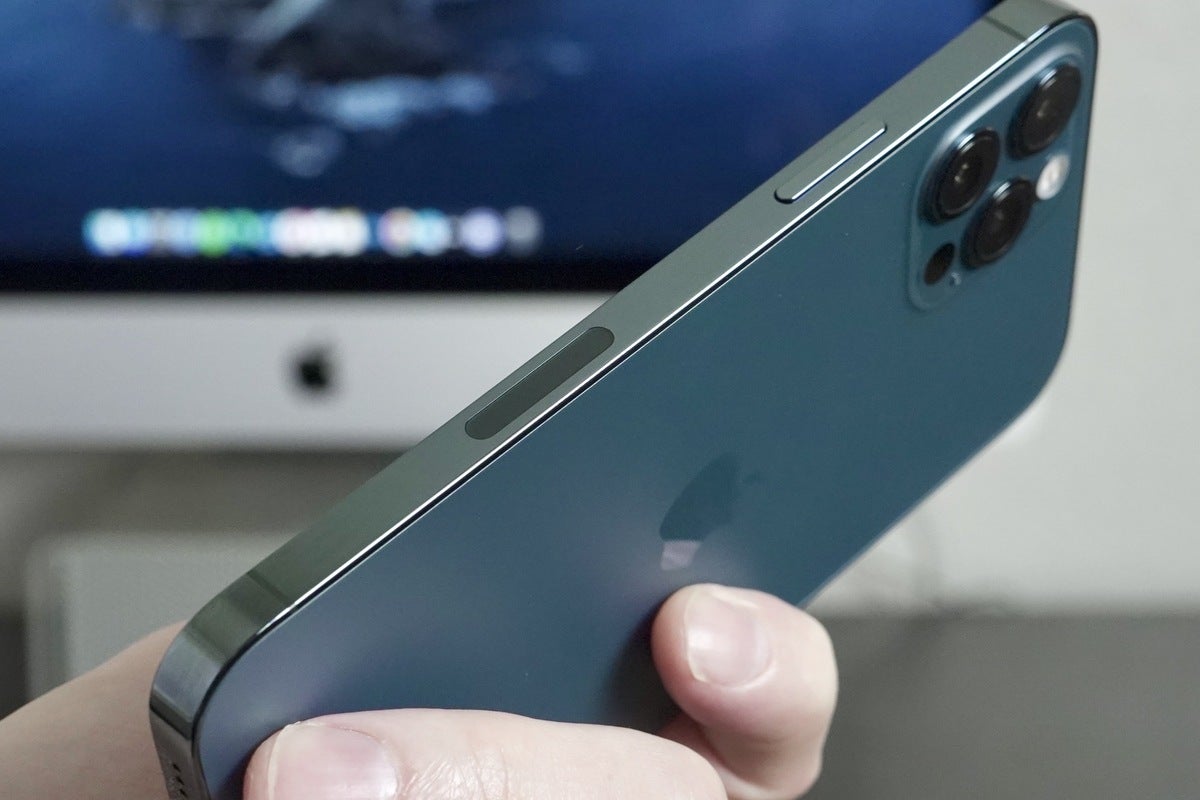 Jason Cross/IDG
Jason Cross/IDG
The new flat-edged design looks and feels great. That oval cutout on the side is the mmWave antenna on U.S. models.
As great as this display is, we’d still like to see an always-on display feature similar to that on the latest Apple Watches (and as Android has had for years). And it feels like the ProMotion feature of the iPad Pro, which offers variable refresh rates up to 120Hz, should have made the leap to the iPhone Pro by now.
The new design is a little slimmer, down from 8.1mm to 7.4mm. This makes the phone feel great in the hand, even with a case on, but it comes at a cost. The battery has shrunk from 3,046 mAh in the iPhone 11 Pro to 2,815 mAh in the iPhone 12 Pro.
That reduction in battery capacity is not met by a reduction in battery life, however. In our tests, which involve setting the display at a constant brightness of 200 nits (roughly halfway on these phones) and running the Geekbench 4 battery life benchmark until the phone dies, the iPhone 12 Pro actually lasted about 50 minutes longer than the iPhone 11 Pro. We should note that our battery tests do not rely on cellular data, and 5G is a significant battery drain, so your mileage may vary.
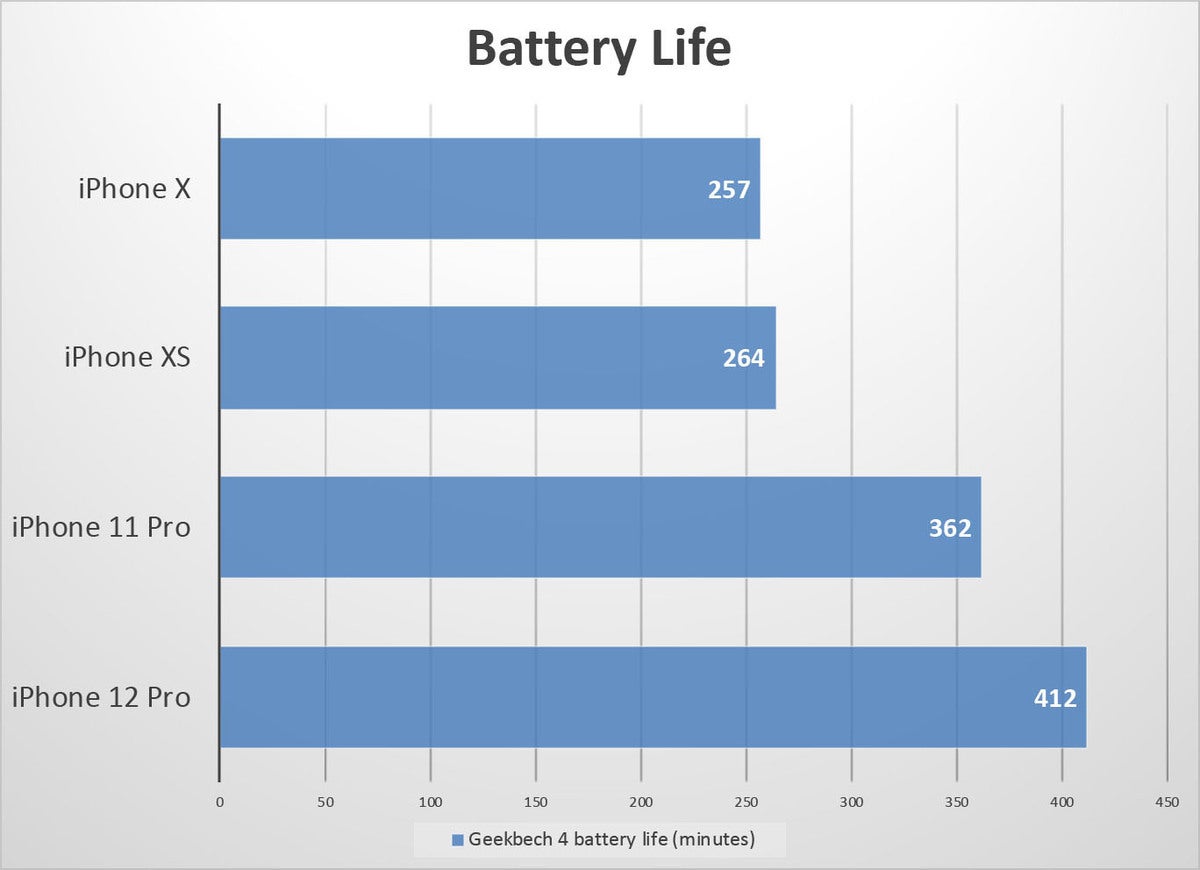 IDG
IDG
Despite having a slightly less battery capacity, battery life is actually better—if you’re not on 5G.
An 8 percent reduction in battery capacity with a 14 percent increase in battery life, despite having a slightly larger display, speaks to the efficiency of the A14 processor. Still, we can’t help but dream of how long these phones would last if Apple stuck with the totally reasonable thickness of 8.1mm and used that extra internal space to give us a 3,400 mAh battery (still far less than comparable premium Android phones!).
Apple promises improved durability with the iPhone 12 Pro, too. The IP68 water and dust resistance is boosted to 30 minutes at six meters instead of four in the iPhone 11 Pro, and the flat edges apparently slightly improve the ability to withstand edge impacts. The front and back glass have the same scratch-resistance treatment as last year, but the glass on the display now goes through an additional strengthening process. Apple calls it “Ceramic Shield” as it imbues the front glass with nanoscopic ceramic crystals. Apple says this makes it four times as shatter-resistant as previous iPhones.
The fastest phone around (not that you’d notice)
So it appears the A14 is more power-efficient than the A13 and can squeeze more life out of a smaller battery. How much faster is it?
The new 5nm manufacturing process helps Apple cram more logic and cache into this chip (11.8 billion transistors!), and likely allows for significantly higher maximum clock speeds. Single-threaded performance leaps up about 19 percent in Geekbench 5. Multi-threaded performance scores a more modest 11 percent higher (but in the older Geekbench 4 benchmark, it’s closer to 23 percent higher).
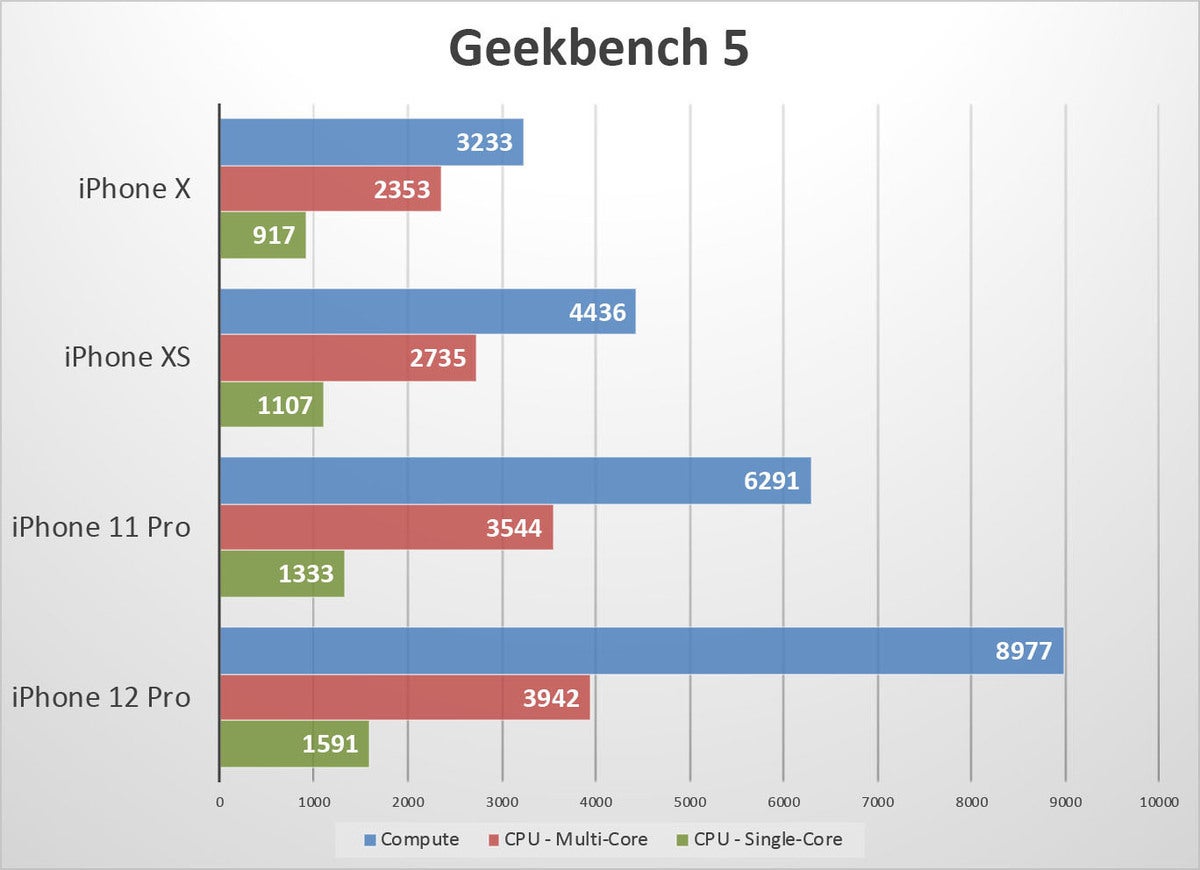 IDG
IDG
Apple continues to make great strides in CPU and GPU compute performance.
That’s a significant leap for one generation, and that single-threaded performance score is higher than some of the newest laptop processors from Intel or AMD. Of course, you can’t always compare mobile and desktop/laptop silicon, and Geekbench’s burst tests are not a good measure of sustained performance. None of that should take away from Apple’s accomplishment here: The CPU in the iPhone 12 is by all accounts dramatically faster than anything else in any other smartphone.
GPU performance is a little harder to nail down. In some tests, particularly modern 3D graphics tests like the new 3DMark Wild Life benchmark, the A14 runs no faster than the A13. In other 3D graphics tests, like the “unlimited” versions of 3DMark’s Wild Life or the old Ice Storm test, it’s bit little faster.
 IDG
IDG
Some 3D graphics benchmarks show little difference from last year’s A13.
When the GPU is used for computation rather than graphics rendering, it seems to be quite a bit faster; from 20 to 40 percent faster according to Geekbench benchmarks.
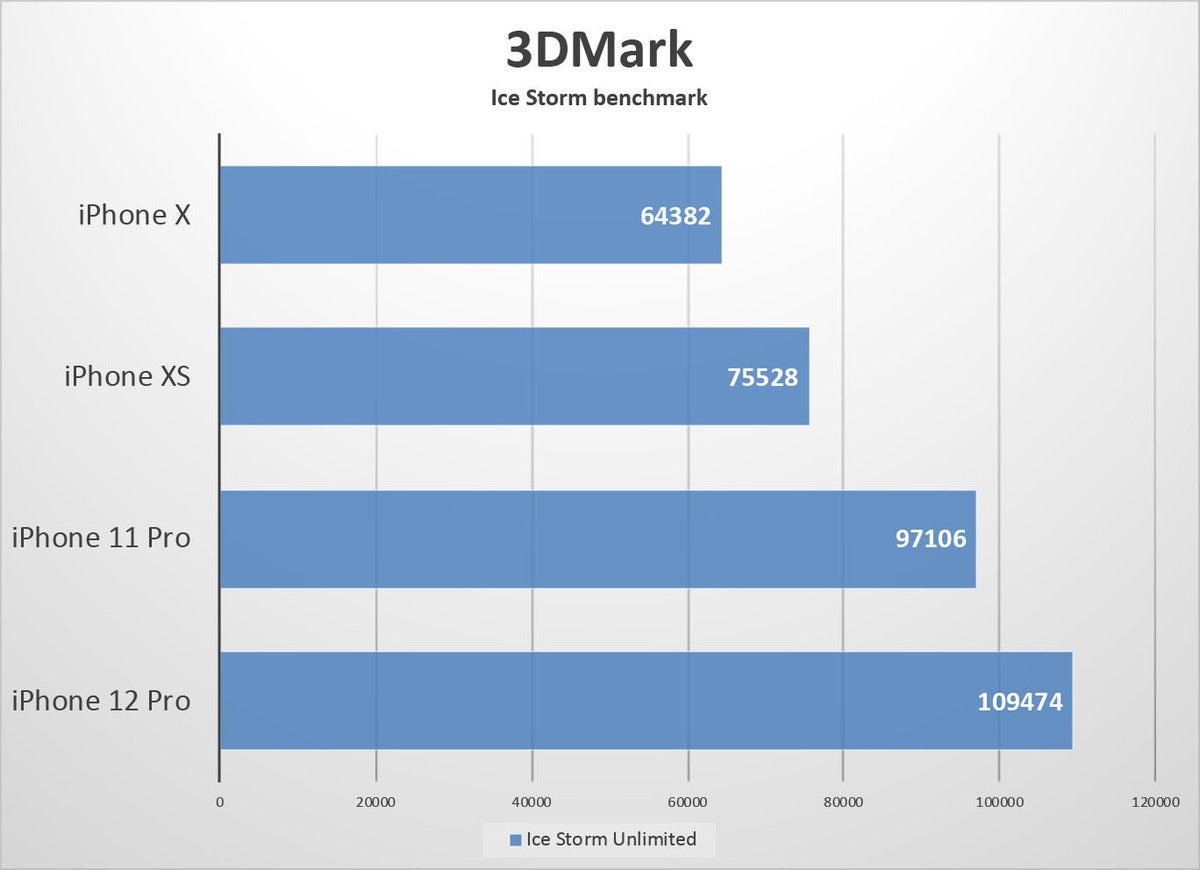 IDG
IDG
Other graphics benchmarks show a noticeable improvement. It’s a strange situation.
The A14 GPU is a four-core design like the A13, but we don’t know what architectural changes Apple has made, nor how much faster the clock speeds can ramp up thanks to the 5nm manufacturing process.
At the end of the day, you’re not likely to notice a significant difference in CPU or GPU performance in the iPhone 12 Pro compared to the iPhone 11 Pro. Both phones are way faster than modern software calls for, and a whole lot faster than any three or four-year old iPhone. It absolutely flies through every app or game you can throw at it.
Only a few years down the line—when we’re talking about iOS 17 and the apps that go with it—are we likely to really see a marked difference between the iPhone 11 Pro and the iPhone 12 Pro thanks to its faster processor and extra 2GB of RAM (from 4GB up to 6GB).
Apple doubled the number of cores in the Neural Engine, a part of the A14 that accelerates machine-learning and AI code, taking its performance from 6 trillion operations per second to 11 trillion. This is almost impossible to reliably measure, but machine learning code is used so pervasively throughout iOS and Apple’s apps that it’s likely to make a big difference in everything from Siri to Photos processing.
One area you’ll notice an immediate improvement over last year’s “Pro” iPhone—and in fact every premium iPhone since the iPhone X—is the storage capacity. The iPhone 12 Pro starts with 128GB of storage instead of 64GB in those earlier models (upgrades to 256GB or 512GB are also available). It’s a welcome change that probably should have come to Apple’s $1,000-plus phones last year.
5G for everyone
Apple’s event announcing the iPhone 12 said the words “5G” about a sixty times in less than an hour. (I counted!) The company really wants you to know that the new iPhones have 5G.
There’s no real difference between the 5G capabilities of the regular iPhone 12 and the iPhone 12 Pro, though there are differences internationally—on either phone, only the U.S. version supports mmWave frequencies.
 IDG
IDG
5G isn’t just about multi-gigabit mmWave speeds. It can really improve performance out on the edge of the network even in the sub-6 frequencies.
It’s a big deal—and also not a big deal. In less than a month, Apple is likely to more than double the number of 5G phones in circulation. The demand is there. The networks, for the most part, are not yet.
2020 was supposed to be the big buildout year for 5G networks, and while coverage has definitely expanded, it’s still not the kind of thing you’re going to find everywhere yet. Even when you do, you’re likely to get speeds between 50 to 100 percent faster than what you got on 4G LTE networks, not the multi-gigabit speeds the ads promise.
That’s not necessarily a bad thing. Most people keep their iPhones for more than a year. Long before you move on from your iPhone 12 Pro, you’ll probably have 5G coverage in most of the places you go. It’s a great thing to have in a new thousand-dollar phone, it’s just not that important right now.
 IDG
IDG
Apple’s solution to preserving battery life with 5G is to switch it on and off automatically.
Remember when I talked about the impressive battery life of the iPhone 12 Pro, despite its lower battery capacity? Well, here’s the rub: 5G connections are way more power-hungry than 4G LTE, especially when connected to those super-fast mmWave towers. Apple’s solution to extend battery life is an auto-5G mode that connects to 5G only when needed, but drops back to LTE the rest of the time. This mode is enabled by default, but you can force 5G on all the time or stick to only LTE to save battery life.
It’s too early to say how well this works. We suspect that as 5G coverage improves, we’re going to wish even more that Apple would have prioritized battery capacity over a thinner design.
The most consistently great camera of any phone
If you were to make a list every year of the top three smartphones by camera quality, the latest iPhone would always be on it. Apple is sometimes slower than its competitors to implement new camera features (like night mode or ultra-zoom), and you might find specific conditions in which the latest Samsung or Google phones take better shots.
But you’d be hard-pressed to find a better all-around smartphone camera system. The iPhone 12 Pro delivers remarkably consistent color, exposure, tone mapping, and sharpness in a really wide array of shooting conditions. The new Smart HDR 3 algorithms are better than ever at balancing out tough shooting conditions with bright highlights and dark shadows, motion, tricky lighting, and areas with fine texture.
The iPhone 12 Pro contains very similar camera hardware to last year’s iPhone 11 Pro. You get the same 12 megapixel wide, 2x ultrawide, and 2x telephoto cameras. This year, the standard wide camera has a new seven-element lens with an f/1.6 aperture, letting in a bit more light than the f/1.8 lens on the iPhone 11 Pro. But the rest of the camera features are more about better image processing than improved camera hardware.
 IDG
IDG
The ability to shoot Night Mode with the ultrawide camera opens up lots of new possibilities.
The Deep Fusion technology now works on every camera, including the front-facing selfie camera. And you can shoot night mode shots with any camera except the telephoto. Together with a set of more pro-oriented software features like a true exposure lock and the option to prioritize shot-to-shot latency over post-capture processing, Apple is giving you the tools to capture really professional-looking shots.
 IDG
IDG
Night Mode on the selfie camera isn’t just for near-black environments. Even in just low indoor light, it brings out a lot more detail with less noise.
When it comes to video quality, no smartphone compares to iPhone, and Apple just threw down the gauntlet with the iPhone 12 Pro. You can shoot actual 10-bit Dolby Vision HDR video at 4K resolutions with all iPhone 12 models; up to 30 fps on the iPhone 12 and and 60 fps on the iPhone 12 Pro. You can also take time-lapse video with night mode. And no matter what mode you choose, you’ll get some of the cleanest, highest-quality video of any smartphone.
Later this year, the iPhone 12 Pro will get a software update to enable the new Apple ProRAW photo format. Apple says this will combine the befits of its multi-exposure computational photography with the deep metadata and creative control typical of RAW images on professional cameras. We haven’t had the opportunity to test it out yet, but along with 60 fps Dolby Vision recording and the telephoto camera, it’s another point of difference between the iPhone 12 Pro and the regular iPhone 12.
If you’re really all about that camera, you might want to wait for the release of the iPhone 12 Pro Max. That model has a couple notable changes from its smaller sibling. The standard wide lens has a much larger sensor with sensor-shift stabilization, both of which should make a real difference for handheld shots in low light, and the telephoto lens is a little longer (about a 2.5x zoom).

















